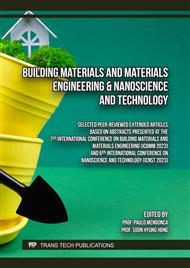[1]
P. Simon and Y. Gogotsi: Nat. Mater. Vol. 19 (2020), pp.1151-1163.
Google Scholar
[2]
S. Fleischmann, J.B. Mitchell, R. Wang, C. Zhan, D. Jiang, V. Presser and V. Augustyn: Chem. Rev. Vol. 120 (2020), pp.6738-6782.
DOI: 10.1021/acs.chemrev.0c00170
Google Scholar
[3]
Y. Zhou, H. Qi, J. Yang, Z. Bo, F. Huang, M.S. Islam, X. Lu, L. Dai, R. Amal, C. Wang and Z. Han: Energy Environ. Sci. Vol. 14 (2021), pp.1854-1896.
DOI: 10.1039/d0ee03167d
Google Scholar
[4]
N. Choudhary, C. Li, J. Moore, N. Nagaiah, L. Zhai, Y. Jung and J. Thomas: Adv. Mater. Vol. 29 (2017), p.1605336.
DOI: 10.1002/adma.201605336
Google Scholar
[5]
C. Choi, D.S. Ashby, D.M. Butts, R.H. DeBlock, Q. Wei, J. Lau and B. Dunn: Nat. Rev. Mater. Vol. 5 (2020), pp.5-19.
Google Scholar
[6]
Q. Pan, F. Zheng, D. Deng, B. Chen and Y. Wang, ACS Appl. Mater. Interfaces: Vol. 13 (2021), pp.56692-56703.
DOI: 10.1021/acsami.1c19320
Google Scholar
[7]
S. Liu, L. Kang, J. Zhang, E. Jung, S. Lee and S.C. Jun: Energy Storage Mater. Vol. 32 (2020), pp.167-177.
Google Scholar
[8]
W. Guo, C. Yu, S. Li, X. Song, H. Huang, X. Han, Z. Wang, Z. Liu, J. Yu, X. Tan and J. Qiu: Adv. Mater. Vol. 31 (2019), p.1901241.
Google Scholar
[9]
C. Jing, B. Dong and Y. Zhang: Energy Environ. Mater. Vol. 3 (2020), pp.346-379.
Google Scholar
[10]
J. Mei, T. Liao, G.A. Ayoko, J. Bell and Z. Sun: Prog. Mater. Sci. Vol. 103 (2019), pp.596-677.
Google Scholar
[11]
X. Zhao, L. Mao, Q. Cheng, J. Li, F. Liao, G. Yang, L. Xie, C. Zhao and L. Chen: Chem. Eng. J. Vol. 387 (2020), p.124081.
Google Scholar
[12]
M. Tong, S. Liu, X. Zhang, T. Wu, H. Zhang, G. Wang, Y. Zhang, X. Zhu and H. Zhao: J. Mater. Chem. A Vol. 5 (2017), p.9873.
Google Scholar
[13]
S. Liu, Q. Zhao, M. Tong, X. Zhu, G. Wang, W. Cai, H. Zhang and H. Zhao: J. Mater. Chem. A Vol. 4 (2016), p.17080.
Google Scholar
[14]
K. Kong, J. Hyun, Y. Kim, W. Kim and D. Kim: J. Power Sources Vol. 437 (2019), p.226927.
Google Scholar
[15]
M.G. Park, J.H. Song, J.S. Sohn, C.K. Lee and C.M. Park: J. Mater. Chem. A Vol. 2 (2014), pp.11391-11399
Google Scholar
[16]
J. Zhu, T. Sun, J. Chen, W. Shi, X. Zhang, X. Lou, S. Mhaisalkar, H.H. Hng, F. Boey, J. Ma and Q. Yan: Chem. Mater. Vol. 22 (2010), pp.5333-5339.
DOI: 10.1021/cm101663w
Google Scholar
[17]
K.P. Annamalai, S. Gokulnath, T. Boobalan and M. Sathish: Compos. B. Eng. Vol. 260 (2023), p.110747.
Google Scholar
[18]
K. Xu, X. Liu, J. Liang, J. Cai, K. Zhang, Y. Lu, X. Wu, M. Zhu, Y. Liu, Y. Zhu, G. Wang, and Y. Qian: ACS Energy Lett. Vol. 3 (2018), pp.420-427.
DOI: 10.1021/acsenergylett.7b01249
Google Scholar
[19]
T.H. Hong, J.Y. Kee, D. Kwon, S. Park and D. Kim, J.T. Lee: ACS Appl. Energy Mater. Vol. 5 (2022), pp.12583-12591.
Google Scholar
[20]
Z. Zheng, X. Shi, D. Ao, W. Liu, Y. Chen, F. Li, S. Chen, X. Tian, X. Li, J. Duan, H. Ma, X. Zhang, G. Liang, P. Fan and Z. Chen: Nano Energy Vol. 81 (2021), p.105683.
DOI: 10.1016/j.nanoen.2020.105683
Google Scholar
[21]
J. Zhao, Y. Wang, Y. Qian, H. Jin, X. Tang, Z. Huang, J. Lou, Q. Zhang, Y. Lei and S. Wang: Adv. Funct. Mater. Vol. 33 (2023), p.2210238.
Google Scholar
[22]
J. Yang, C. Yu, X. Fan, S. Liang, S. Li, H. Huang, Z. Ling, C. Hao and J. Qiu: Energy Environ. Sci. Vol. 9 (2016), pp.1299-1307.
Google Scholar
[23]
D. Cheng, Y. Yang, J. Xie, C. Fang, G. Zhang and J. Xiong: J. Mater. Chem. A Vol. 3 (2015), pp.14348-14357.
Google Scholar
[24]
L. Xu, Y. Xi, W. Li, Z. Hua, J. Peng, J. Hu, J. Zhou, P. Zhang, J. Wang, W. Wang, H. Ding, W. Wang, W. Ji, Y. Yang, X. Xu, L. Chen and X. Li: Nano Energy Vol. 91 (2022), p.106630.
DOI: 10.1016/j.nanoen.2021.106630
Google Scholar
[25]
N. Elgrishi, K.J. Rountree, B.D. McCarthy, E.S. Rountree, T.T. Eisenhart and J.L. Dempsey: J. Chem. Educ. Vol. 95 (2018), pp.197-206.
DOI: 10.1021/acs.jchemed.7b00361
Google Scholar
[26]
D. Shi, M. Yang, B. Zhang, Z. Ai, H. Hu, Y. Shao, J. Shen, Y. Wu and X. Hao: Adv. Funct. Mater. Vol. 32 (2022), p.210884.
Google Scholar



